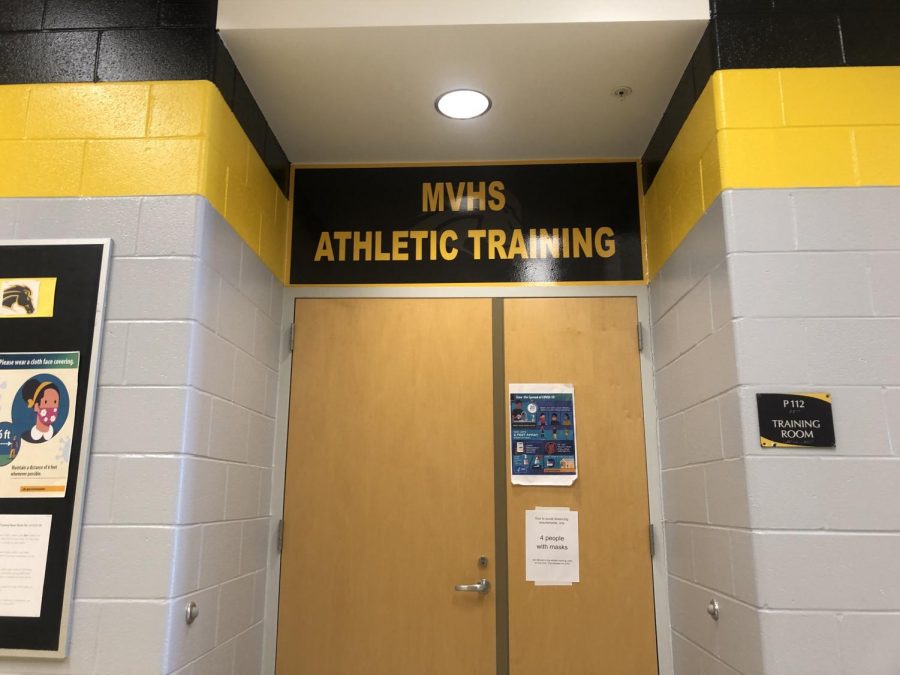Athletic trainers handle upcoming sports season with new precautions
As Metea sports resume, athletic trainers have made adjustments to practices and created new protocols to keep athletes safe.
The pandemic took a huge hit to the sports season. The Illinois High School Association [IHSA] announced last Tuesday that it is safe to resume most sports such as boys’ and girls’ basketball, dance, cheerleading, boys’ soccer, football, and more sports. Since many sports like football and girls’ volleyball were not able to play in the fall, their seasons will start in the spring. Precautions and changes are put in place following Illinois Department of Public Health guidelines as well as CDC guidelines to assure that sports can be played safely and effectively.
With Illinois reaching Phase 4, athletic trainers have made necessary changes to the athletic training center to assure that athletes have a semi-normal season. Basic sanitation and social distancing rules are incorporated in the athletic training center.
“At least in our athletic training world, there has been a lot of changes in athletics in general,” Metea Athletic Trainer Andrea Kovalsky said. “Here in the athletic training room we have masks on all the time, and based on the size of the room we can really only allow four people in at a time due to social distancing.”
Although sanitation and social distancing protocols are in place, rules about athletes coming into contact with other athletes are still allowed, such as football tackling.
“The actual games haven’t changed much for them,” Athletic Trainer Jake Reist said. “The biggest change is that they are going to have to wear masks during competitions. Every indoor and outdoor sport will be wearing masks during the competition. The benches will be more spaced out, but their game will stay the same. They didn’t change any rules.”
The biggest change has been the push for better hygiene in the athletic training room. The extensive washing of hands and the constant sanitization of the equipment has been a required but tedious task that the trainers adjusted to.
“Not a lot about the way we treat injuries has changed,” Kovalsky said. “We still track athletes by requiring that they sign in when they visit the athletic training room and encourage them to practice good hygiene by washing their hands before and after treatment. There is always a little risk in being near someone while administering treatment, but we keep our masks on and minimize the amount of time they spend with us, which helps keep the risk low.”
The mask rule is in place almost all the time while an athlete is in the athletic training room. There are a few exceptions to this rule though. If there is an injury where the mask is in the way or the athlete is having trouble breathing, then they are allowed to remove the mask to better their treatment.
“We do require that athletes wear their mask the entire time they’re in the athletic training room, except of course if they have a nose or mouth injury or are having significant difficulty breathing,” Kovalsky said. “Besides that, we sanitize equipment and treatment tables after every person that uses them and limit the number of people that can be in the athletic training room at one time, in order to keep our distance.”
The trainers have been impacted the most by the lack of sports during the last 10 months. Students thankfully have seen high school sports back in action, but during the summer and early winter, it was a struggle to have part of their jobs stripped away from them.
“For me personally, it has been challenging, to be honest,” Kavolsky said. “I am sure that most students miss going to school and playing sports like they used to do just like I miss the way my job used to be. I think the thing I struggled with the most was when sports were shut down completely back in November, and I could not do anything to help. I just had to wait it out like everyone else.”
IHSA made the decision to move high contact sports to later in hopes that COVID-19 cases will start to go down and high contact sports will become safer to play. Many of the higher contact sports such as wrestling have been moved to later in April. The hope for the athletic department is that by then, COVID-19 cases will decrease and it will be safer to hold high contact sports.
“I think more than anything, we are just excited that athletes have the opportunity to play these sports,” Kovalsky said. “Athletic trainers are eager to start the season and let players have playtime, even if things look a bit different now.”



